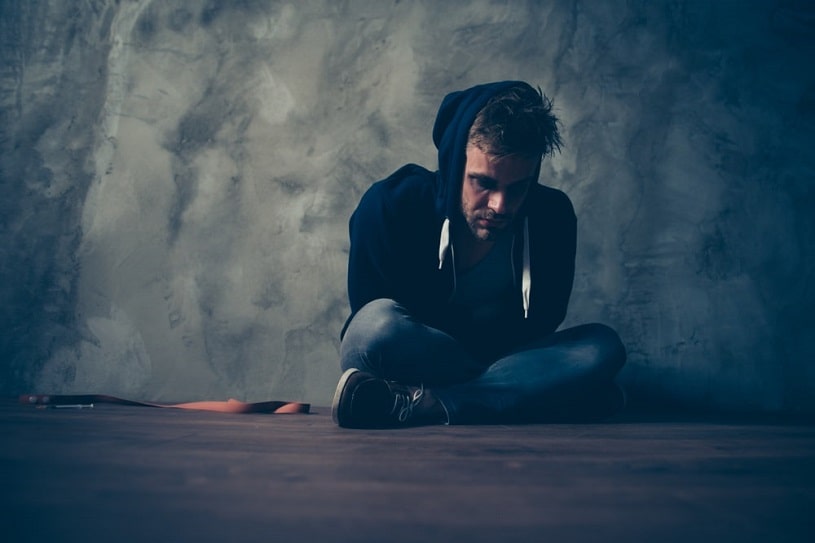Ativan (brand name for Lorazepam) is a prescription drug belonging to the drug class of benzodiazepines. It is prescribed to help treat anxiety disorders, anxiety caused by depression, anxiety before medical procedures, insomnia, epilepsy, and Irritable Bowel Syndrome (IBS), as well as the treatment of other health conditions.
Table Of Contents:
When a person uses the drug for more than 2 weeks, dependency and addiction can be developed. Therefore, quitting using Lorazepam tends to lead to the appearance of withdrawal symptoms. Even those who take the medication in small doses or for a short time are at risk of experiencing unpleasant withdrawal symptoms.
It happens because once the body gets used to the effects of certain drugs, users grow accustomed to it and may develop a dependency. When those drugs are stopped abruptly, the body notices and attempts to account for its absence in the body, usually with disastrous results.
The body begins to feverishly try to return to its state of function before the drug was introduced. This process is called withdrawal, and it can have very unpleasant, potentially dangerous, and even life-threatening consequences.
For those with a more severe addiction, who seek help, there are special detox centers where they can safely undergo the withdrawal and recovery process under the supervision and care of medically trained personnel. These centers give the insurance of a safer and more effective detox process.
Withdrawal From Ativan
Ativan is habit-forming and can lead to physiological and psychological dependence and withdrawal symptoms. Therefore, it should be taken cautiously, according to a doctor’s prescription.
Pfizer, the manufacturer of Ativan, warns against using the drug for more than 2-4 weeks because of its high potential for dependency, leading to addiction.
If someone chooses to discontinue their use of Ativan after a prolonged period, they are likely to experience withdrawal symptoms. It is not advisable to stop taking Ativan abruptly and without contacting your doctor first or seeking professional help.
Ativan Withdrawal Symptoms
Ativan has an intermediate half-life of about 12 hours. So withdrawal symptoms may begin within 24 hours after cessation of the drug. These symptoms are often divided into two stages: acute and prolonged.
Acute Symptoms
- Headaches
- Tension
- Sweating
- Cravings
- Nausea
- Dizziness
- Vomiting
- Hyperthermia
- Increased blood pressure
- Rapid heart rate
- Increased sensitivity to sound and/or light
- Abdominal cramps
- Weight loss
- Muscle stiffness or pain
- Body aches
- Hand tremors
- Palpitations
- Numbness or tingling around extremities
Apart from physical symptoms there might be some cognitive and emotional manifestations, which also make the withdrawal more difficult.
Some Of Them Are:
- Confusion
- Irritability
- Concentration problems
- Delirium
- Anxiety
- Panic attacks
- Mood swings
- Insomnia
- Depression
Prolonged Symptoms
- Anxiety
- Insomnia
- Cognitive depreciation
- Tinnitus
- Paraesthesia
- Motor symptoms; pain weakness, tremors, tension, jerks, blepharospasm
- Gastrointestinal symptoms
- Memory problems
- Reduced ability to feel pleasure
- Initiative deficiency and decreased interest
- Concentration problems
- Fatigue or constant tiredness
- Obsessive-compulsive tendencies
- Resurfacing of some acute symptoms
Factors That May Influence Withdrawal
Certain factors may influence how long the withdrawal period lasts, namely, the period of usage and the dosage. The more dependent the body has become, the more severe and drawn-out the withdrawal process will be.
The method of administration will also influence the duration and severity of withdrawal from lorazepam. Those taking the drug by prescription will take it in pill form.
Factors Which Might Prolong Ativan Withdrawal Include:
- Exposure to high doses of Ativan
- Taking the drug often
- Prolonged duration of drug use
- Abusing other substances such as alcohol
- Route of administration
- Other factors, such as the emotional, psychological, and physical composition of a person.
Mental health disorders and other drug abuse, in combination with Ativan, are both likely to lengthen the process.
Ativan Withdrawal Timeline
The Ativan withdrawal timeline begins within 24 hours after the last dose. It begins with the acute phase—when the most severe physical indicators occur—and typically continues for 3-4 days.
This is followed by the prolonged phase, which typically lasts for 10-14 days and during which these manifestations somewhat lessen. Mild signs may continue for years after quitting Ativan until the addict receives proper treatment for anxiety and craving-related thoughts and behaviors.
Ativan Acute Withdrawal Phase
The acute phase can last for up to 3-4 days after the last dose. During this phase, users experience the most severe symptoms.
Ativan Prolonged Withdrawal Phase
The prolonged phase follows the acute phase and can last between 10 and 14 days. Apart from the usual indicators, such as general malaise, headaches, and nausea, patients may experience depression and cravings. Some patients who struggle with depression may experience suicidal thoughts, which can lead to suicide attempts.
The symptoms listed above are not a complete list of possible ones. Depending on certain individual factors and a history of drug abuse, the duration of symptoms may vary.
Individual Factors May Affect the Duration Due to any of the Following:
- Body size differences
- Presence of co-morbid mental problems in some people
- History of addiction
Note that some users experience a lack of motivation and mood swings for up to a few years after detoxification.
Ativan Detox Assistance
Symptoms will be most pronounced in patients with more severe drug abuse issues. Such persons may want to undergo the withdrawal, detoxification, and recovery process in a designated detox center.
Tapering
Gradual tapering is the medically recommended process for coming off of Ativan. A doctor will be able to assist and monitor this process, checking vitals and watching for seizures and respiration issues. If necessary, mental health professionals are also available to provide emotional support throughout the detox.
Patients may suffer from depression and suicidal thoughts while going through lorazepam withdrawal, and having support can greatly decrease the risk of acting on these feelings. Detox centers are the safest places to undergo the withdrawal and recovery process.
Medically Assisted Detox
Patients who experience severe manifestations of benzodiazepine withdrawal may require detox for complete treatment of dependence on the drug. This involves clearing up remnants of the toxic substance from the body. The process can be difficult and stressful, even life-threatening in some cases.
Medically assisted cleansing at a certified center is safer and guarantees higher chances of success. It aims to lessen the adverse effects of the detox process and simultaneously treat co-morbid mental health problems encountered by the patient.
Treatment of the adverse effects of dependency on benzodiazepines involves getting rid of the substance from the body first. Getting involved in a medically assisted detoxification routine gives better insurance of fuel recovery following lorazepam withdrawal. Recovery usually follows within a few weeks to months of commencing treatment.
Most patients who finally recover from substance abuse affirm this cleansing process as the first step to recovery. This is because the substance must be flushed out of the body before any tangible progress can be recorded in treating the addiction and give insurance of complete healing.
Though flushing out doesn’t make up for treatment, it guarantees the patient’s safety and gives insurance against certain adverse effects of benzodiazepine withdrawal. Detoxification outside professional medical help can be fatal due to the dangerous effects of lorazepam withdrawal on the body and brain, manifested in tremors, delirium, seizures, and other problems.
Undergoing this process at a certified center reduces the risk associated with these extreme conditions. Trying to quit contact cold turkey at home to no avail has proven to increase the tendency of relapse.
Here are Some of the Benefits of Undergoing Medically Assisted Detoxification:
- Reduced incidence of adverse or even life-threatening events during the detoxification process
- Availability of prescription medication to further help combat detox symptoms
- Discovery and treatment of co-morbid conditions
Maintain a Healthy Lifestyle
In addition to the medical and mental health support a user will receive at a center, they will also be instructed to make changes to their lifestyle, such as getting frequent exercise, cutting down alcohol, reducing their chances of coming in contact with the drug, and eating a healthy diet. Research shows that practicing yoga, meditation, and breathing techniques can help reduce anxiety and improve the patient’s emotional and mental state.
Lorazepam addiction is a challenging condition to overcome. However, with the right attitude, support system, and medical assistance, many people move on to make full recoveries. The journey may be long, but the destination makes it all worth it in the end.
The first step to recovery is seeking professional help and treatment for your addiction. Contact your doctor to know how you can find the proper care for yourself or someone close to you.
Page Sources
- Prescribing Information, ATIVAN (2019). Warning Against Prolonged Usage of Ativan. https://www.pfizer.ca/sites/default/files/201902/ATIVAN_PM_E_221513_31Jan2019.pdf
- Challenges of the pharmacological management of benzodiazepine withdrawal, dependence, and discontinuation (2018). Tapering of BZD. https://www.ncbi.nlm.nih.gov/pmc/articles/PMC5896864/#__ffn_sectitle
- Harvard Mental Health Letter (2009). Yoga for Anxiety and Depression. https://www.health.harvard.edu/mind-and-mood/yoga-for-anxiety-and-depression
- Pétursson H. The benzodiazepine withdrawal syndrome. Addiction. 1994. https://www.ncbi.nlm.nih.gov/pubmed/7841856.
- The U.S. Department of Health & Human Services. Lorazepam – Medical Countermeasures Database. 2019. https://chemm.hhs.gov/countermeasure_lorazepam.htm.
- Benzodiazepine withdrawal. https://healthywa.wa.gov.au/Articles/A_E/Benzodiazepine-withdrawal
- Management of benzodiazepine misuse and dependence. 2015. https://www.ncbi.nlm.nih.gov/pmc/articles/PMC4657308/
- Principles of Drug Addiction Treatment: A Research-Based Guide (Third Edition)- Principles of Effective Treatment. 2018. https://www.drugabuse.gov/publications/principles-drug-addiction-treatment-research-based-guide-third-edition/principles-effective-treatment
- Is it safe to go “cold turkey”, i.e. to go from drinking/using drugs heavily to not using at all?. 2018. https://yourroom.health.nsw.gov.au/faq/Pages/going-cold-turkey.aspx

 Authored by
Authored by  Reviewed by
Reviewed by 



